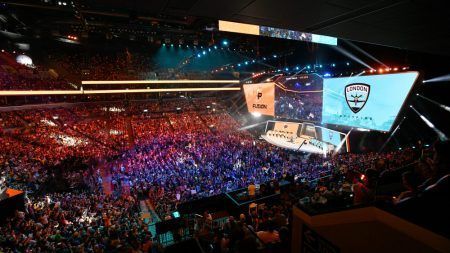The esports industry has come a long way from its early days, when teams were, more often than not, just a bunch of players looking to win bragging rights and a few hundred bucks from grassroots competitions, with the possibility of a sponsorship little more than an occasional bonus.
But nowadays, the industry has been shying away from its roots and leaning more towards the next big thing: multimillion-dollar esports franchises. Just recently, the Call of Duty World League (CWL) has been selling spots for its new franchise league format for $25 million each, per ESPN.
The CWL joins the likes of the Overwatch League (OWL), as well as the League of Legends esports leagues in Europe and North America, in the growing list of major esports leagues choosing a franchise-based league format. That development is not just happening in the West either, as even the Philippines has begun its own franchise-based esports league.
That this is happening shouldn’t be much of a surprise given the meteoric rise of the esports industry in recent years. According to the research firm Newzoo, the total revenue of the industry jumped from $493 million in 2016 to $655 million in 2017. That figure was expected to exceed $900 million last year, and would further baloon to over $1 billion by this year.
You can be sure all that money would turn heads, which it most definitely did. The OWL team Boston Uprising is currently owned by the Kraft Group — which is itself owned by owner of the NFL team New England Patriots, Robert Kraft. Other big money entities owning esports franchises include the likes of Comcast Spectacor and Kroenke Sports & Entertainment — the holding company of several professional sports franchises such as the Los Angeles Rams and the Denver Nuggets.
All those big names in esports paint a bigger picture for the industry — one that has it emulating major traditional sports leagues such as the NFL and the NBA.
Such a movement is undeniable, no matter how many times esports may be barred from the Olympics. It’s one that makes sense too, if traditional sports make a lot of money then esports can do it too, right?
Yeah, sure… It’s hard to question the sheer revenue that esports has been raking in. However, it’s no guarantee for success.
Take the OWL, for example. Despite its illustrious atmosphere as the pioneering esports franchise league, its viewership peaked at just 436,789 people (excluding the Chinese audience) during the first stage of its inaugural season. The OWL continually lost viewers for months after that, and even its second season viewership has been seeing a downward trend.
While that can be attributed to Overwatch not being the most viewer-friendly esport, the figures also point towards a major difference between esports and traditional sports franchises.
In traditional sports, fans primarily support the franchise and brand based on their home cities or states. The same cannot be easily said for esports, where fans are more supportive of individual players or teams — regardless of which organization or franchise they play under.
Let’s say you are a New Yorker, would you be keen on supporting the New York Excelsior if you found out its roster is consisted solely of South Koreans?
Most esports fans would say that they support SK Telecom or Team Liquid not because they are fans of those franchises per se, but rather because superstars like Faker and Miracle- play for those teams.
It’s a byproduct of how esports was in its early days — which was only just a decade ago, mind you — when transient teams filled with players scrambled for breakthroughs in grassroots competitions. That’s not something that can be easily undone by throwing a lot of cash at it.
It’s one of the reasons why Dota 2, one of the older and more successful esports titles, does not have an overarching competitive league with guaranteed spots for franchises. The game’s competitive scene revolves around a season-long circuit of tournaments leading up to the yearly iteration of The International, which gave away a record $26 million in prizes last year.
Teams in Dota 2 are not monolithic, but they rise and fall depending on the players. Past championship teams like Natus Vincere and Alliance are barely tier-two teams now, but the players capable of winning a chip are still gunning for it — just under different banners.
With all that said, everything boils down to how esports is reacting to changes necessitated by its sudden and unprecedented growth.
It’s difficult to go against the notion that franchise-based leagues are the future of the industry, but it’s equally hard to say that model will be successful compared to the tried-and-true ways of the past.
Still, the industry is young and growing, even after all the growth it went through in recent years. There is room for more of such growth, and that can be only be taken up by both opportuny and risk.

